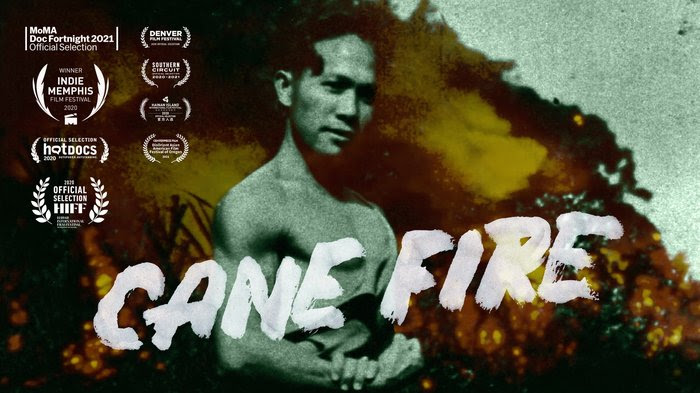Doc Corner: The Hollywood history of 'Cane Fire'
 Wednesday, May 18, 2022 at 6:31PM
Wednesday, May 18, 2022 at 6:31PM By Glenn Dunks

A history of exploitation unfurls in Anthony Banua-Simon’s Cane Fire like the plot of a Hollywood movie. A deeply empathetic documentary, Cane Fire takes its title from a Lois Weber film, White Heat. That film, Weber’s last from 1934, is considered lost and survives only in images and fragments. As Banua-Simon shows, that is a lot like the non-white population of the island of Kaua’i, where it was filmed, who have been worked until their backs were broken by a series of industries that have crushed and sapped the non-white population like you would strip bare sugar cane.
First it was sugar cane and pineapples, then Hollywood who used locals as extras in bright and colourful productions starring big names like Elvis Presley and John Wayne. Today it’s tourism—an industry that has caused Hawaii more broadly to become the most expensive state to live in, something that is inceasingly out of grasp to many of the population who predominantly work as service staff at hotels and resorts. If you saw The White Lotus, then maybe you could consider this its darker companion piece...
Working here as his own editor, Banua-Simon lays this history out in a way that allows its many complex shifts to resonate beyond just a litany of shameful acts against people whose land was taken and divided by conglomerates. One of his most interesting and quite shocking evolving revelations is how all of the businesses who appear to have a stake in the island’s current industry of capitalistic exploitation are the same ones who originally brought the exploitative sugar manufacturing businesses to the island 100 years earlier. Banua-Simon uses his own family’s experience as a thread—his great-grandfather, a Filipino immigrant, worked as an extra on White Heat while simultaneously off-camera planting the seeds for a union movement that, to this day, struggles to bring the residents of Kaua’i a suitable living wage (something that is sadly not unfamiliar to many in tourism-centric destinations).

Despite what the movies of Adam Sandler may suggest, there is a determined spirit remaining in the people of Kaua’i and we witness moments of this throughout. However, Banua-Simon is just as willing to allow us to ruminate in the aura of this land, spending time with his great-uncle Henry (himself once an extra in the Kevin Costner vehicle, Dragonfly—certainly the first time that has ever come up since its release in 2002) and a former union leader, Alfred. Interspersed throughout are clips of 90-years’ worth of made-in-Kaua’i film and it’s hard not to spot the harmful and regressive stereotypes and blatant disregard for the people who made this place what it is. Something as seemingly innocuous as Just Go With It shows how even today these very colonialist concepts of ‘the natives’ as either lazy or being only too happy to serve the descendants of those who sought to take and give nothing back.
The director’s smartest—and most stylistically jarring (in a good way)—choice is his recurring use of corporate logos, promotional videos and even advertisements including some for absurd businesses owned by and targeted at wealthy white audiences (the mud beach commune was a trip). When at one point, the island’s former mayor labels the architecture of the Kaua’i as “plantation elegance” and you really do get a sense of how far adrift people’s attitudes have gone and how little hope there is that anything can be done within the parameters they have manipulated to be of benefit to them and nobody else. As we see time and time again, the rich and powerful will continue to destroy with little thought to the toll they are taking on anybody else.
Because of this sprawling narrative, Banua-Simon occasionally gives the sense that he wants to cover almost too much and is unable to explore them to degree that perhaps he should. At one moment, his young cousin suggests that everybody on the island is doing meth, while elsewhere the director hints at corruption within several organizations including some fairly unfair and unacceptable work practices within Habitat for Humanity. Additionally, the cinematography (once again by Banua-Simon) is often a bit rough around the edges.
I was impressed by Cane Fire, although its scrappiness stops it short of becoming a great piece of filmmaking. And yet we often talk about how documentaries are preaching to a choir when it comes to issues such as those posed by Anthony Banua-Simon. Here is a movie that might actually allow a viewer to see a place and a subject in a new way. I know I did. And that’s its own kind of special ability. Aided by its essay-like tone, it is a richly personal take on a larger, ever-unfolding tragedy of humanity.
Release: This Friday, May 20th, at BAM in Brooklyn for a week-long engagement.
 Doc Corner,
Doc Corner,  Hawaii,
Hawaii,  Lois Weber,
Lois Weber,  Reviews,
Reviews,  The White Lotus,
The White Lotus,  White Heat,
White Heat,  documentaries
documentaries 

